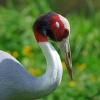Small, dark brown swallow, almost always found near water; upperparts dark brown, wing edges slightly darker, with white throat, half collar and belly contrasting sharply with clearly marked dark brown breast band; clearly forked tail; distinguished from Plain by white throat and half collar distinctly demarcated from dark ear coverts and breast band; gregarious; always with other swallows and swifts; hunts aerially with smallbilled, wide-gaped mouth over water; perches on exposed overhead wires or branches.
- Browse
- Gallery
- Checklists
- Topography
- Glossary
- Bibliography
- Feedback
- About Us







